
|
Pair Work: Listen, draw, write (3)
Pair Work exercise useful for practising speaking and listening skills and giving/following instructions. Put students in pairs and give each half of the worksheet. Student B tells student B where to go on the grid and what to write or draw. Make students can not see each other�s sheet. This ws allows the whole class to practise simultaneously. At ...
Level: elementary
Age: 7-17
Type: worksheet
Downloads: 168
|
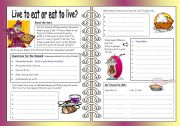
|
Four Skills Worksheet - Live to eat or eat to live?
Four skills worksheet about FOOD. This worksheet may be copied, adapted and freely distributed by all. (Copyright License: Creative Commons Attribution Non-commercial Share-Alike).
Level: elementary
Age: 8-17
Type: worksheet
Downloads: 234
|
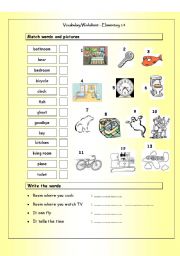
|
Vocabulary Matching Worksheet - Elementary 1.4
Vocabulary worksheet containing general vocabulary. It has two sections: Match words and pictures (matching exercise) and Write the Words (spelling exercise). This worksheet was originally developed to supplement the I-Spy 1 course book (young learners, level 1), but can be used stand-alone without problems.
Level: elementary
Age: 5-17
Type: worksheet
Downloads: 8
|
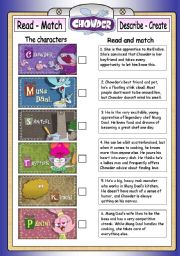
|
Read - Match - Describe - Create: CHOWDER (2)
Multi-skill worksheet for elementary learners practising reading, writing and creativity. Very useful if students like the cartoon series �Chowder� as shown on Cartoon Network. First page has the original (difficult) character descriptions, page 2 has been adapted for elementary language learners (easy language and b/w characters that can be colour...
Level: elementary
Age: 8-17
Type: worksheet
Downloads: 112
|

|
How and where to get IDEAS
Tutorial with some useful tips on how (and where) to get fresh ideas and inspiration to create worksheets. Includes creative thinking exercises on 2nd page. This ws with its clipboard and notebook layout can be freely downloaded and used as a template to create your own work. Get creative now!
Level: elementary
Age: 3-17
Type: others
Downloads: 378
|

|
Board Game - Have you ever...?
With the easy board game, learners will practise the present perfect in an enjoyable way. Every square provides a verb and a picture clue. Every time a correct question is asked, the game can be used as a communicative activity whereby players ask each follow-up questions. (e.g. Have you ever ridden a camel? Where did you do this? Was it fun? How m...
Level: elementary
Age: 8-17
Type: others
Downloads: 1124
|
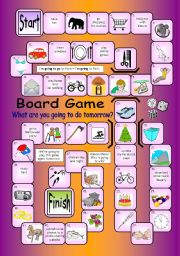
|
Board Game - What Are You Going To Do Tomorrow?
With this board game, learners will practise the future with �GOING TO� in an enjoyable way. Every square provides a picture clue (or some words). Every time a correct answer is given, the game can be used as a communicative activity whereby players ask each follow-up questions. Let�s make learning fun!
Level: elementary
Age: 8-17
Type: others
Downloads: 463
|
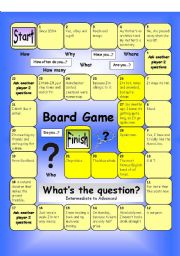
|
Board Game - What�s the Question (Hard)
With this board game, students are given the answer and have to find out what the question is. Very useful to revise making correct questions. Students can be put in team or pairs if the game proves too challenging. You could also give extra rewards for creative questions. Suitable for Intermediate to Advanced students. Let�s make learning English ...
Level: intermediate
Age: 12-17
Type: others
Downloads: 295
|
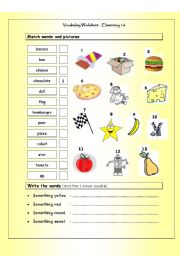
|
Vocabulary Matching Worksheet - Elementary 1.6
Vocabulary worksheet containing general vocabulary. It has two sections: Match words and pictures (matching exercise) and Write the Words (reading & spelling exercise). This worksheet was originally developed to supplement the I-Spy 1 course book (young learners, level 1), but can be used stand-alone without problems.
Level: elementary
Age: 5-17
Type: worksheet
Downloads: 10
|
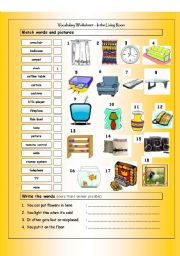
|
Vocabulary Matching Worksheet - IN THE LIVING ROOM
Vocabulary worksheet containing LIVING ROOM vocabulary. It has two sections: Match words and pictures (matching exercise) and Write the Words (creative word writing exercise).
Level: elementary
Age: 6-17
Type: worksheet
Downloads: 95
|